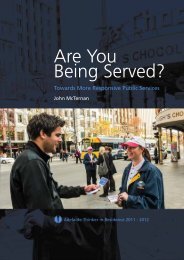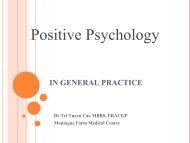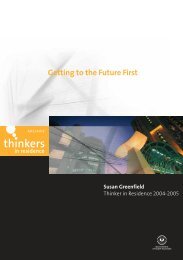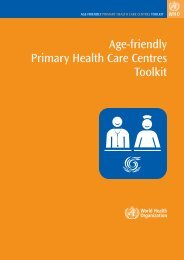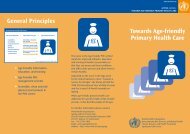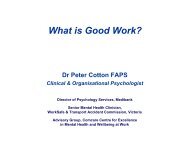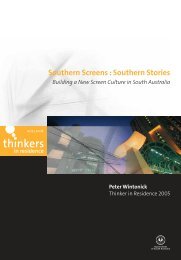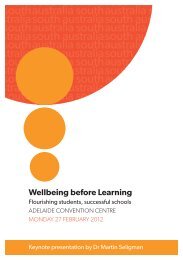Early Child Development - Adelaide Thinkers in Residence
Early Child Development - Adelaide Thinkers in Residence
Early Child Development - Adelaide Thinkers in Residence
You also want an ePaper? Increase the reach of your titles
YUMPU automatically turns print PDFs into web optimized ePapers that Google loves.
Public Lecture & A.W. Jones Oration<br />
<strong>Adelaide</strong>, South Australia<br />
<strong>Early</strong> <strong>Child</strong> <strong>Development</strong> – The<br />
Build<strong>in</strong>g Blocks for Successful<br />
Societies<br />
By J. Fraser Mustard<br />
Found<strong>in</strong>g President, CIAR<br />
<strong>Adelaide</strong> Th<strong>in</strong>ker <strong>in</strong> <strong>Residence</strong><br />
March 19, 2007
New<br />
<strong>Early</strong> <strong>Child</strong> <strong>Development</strong><br />
Clos<strong>in</strong>g the gap between<br />
what we know and what we do
04-131
04-132<br />
“One cannot emphasize too<br />
strongly the importance of those<br />
first years for the course that a<br />
child will follow throughout his<br />
entire life.”<br />
Erasmus (1529, p. 309)
04-133<br />
“Thank you for present<strong>in</strong>g<br />
conclusive evidence about<br />
what we <strong>in</strong>tuitively know.<br />
When we deal with<br />
dysfunctional families, we put<br />
the children <strong>in</strong> limbo, and<br />
damage them permanently.”<br />
Prov<strong>in</strong>cial Court Judges
04-152<br />
WHAT DO<br />
WE NOW KNOW?
03-080<br />
Experience-Based Bra<strong>in</strong> <strong>Development</strong> <strong>in</strong><br />
the early years of life sets neurological<br />
and biological pathways throughout life<br />
that affect:<br />
Health<br />
Learn<strong>in</strong>g<br />
Behaviour
03-013<br />
The Hostage Bra<strong>in</strong> , Bruce S. McEwen and Harold M. Schmeck, Jr., 1994.
04-039<br />
Two Neurons<br />
Axon<br />
RECIPIENT<br />
NEURON<br />
Synapse<br />
SIGNAL-<br />
SENDING<br />
NEURON<br />
Dendrite
04-212<br />
Sound<br />
Vision<br />
Smell<br />
Touch<br />
Proprioception<br />
Taste<br />
Neal Halfon
03-078<br />
Experience and Bra<strong>in</strong> <strong>Development</strong><br />
Stimuli switch on genetic pathways<br />
- differentiate neuron function<br />
Stimuli affect the formation of<br />
the trillion of connections (synapses)<br />
among the billions of neurons
04-042<br />
SENSING<br />
PATHWAYS
03-079<br />
Vision and Hear<strong>in</strong>g<br />
Critical Period<br />
Eye cataracts at birth prevent normal<br />
development of vision neurons <strong>in</strong> the<br />
occipital cortex<br />
(Hubel and Wiesel)<br />
Cochlear defects at birth impair<br />
hear<strong>in</strong>g development<br />
(Rauschecker and O’Donoghue)
New<br />
Bra<strong>in</strong> Pathways<br />
“Higher levels of bra<strong>in</strong> circuits depend on<br />
precise, reliable <strong>in</strong>formation from lower<br />
levels <strong>in</strong> order to accomplish their function.<br />
Sensitive periods for development of lower<br />
level circuits ends early <strong>in</strong> life.<br />
High level circuits rema<strong>in</strong> plastic for a<br />
longer period.”<br />
Knudsen 2004
01-003<br />
Human Bra<strong>in</strong> <strong>Development</strong> –<br />
Language and Cognition<br />
Sens<strong>in</strong>g<br />
Pathways<br />
(vision, hear<strong>in</strong>g)<br />
Language<br />
Higher<br />
Cognitive Function<br />
Conception<br />
-6<br />
-3 0 3 6 9 1 4 8 12 16<br />
Months<br />
Years<br />
AGE<br />
C. Nelson, <strong>in</strong> From Neurons to Neighborhoods, 2000.
New<br />
Allostasis & Allostatic Load<br />
(Stress)
03-002<br />
Sensory<br />
Stimulus<br />
Thalamus<br />
Cortex<br />
Amygdala<br />
Cortisol<br />
Hypothalamus<br />
PVN<br />
CRF<br />
ACTH<br />
PIT<br />
Hippocampus<br />
+ + - -<br />
Cortisol<br />
Adrenal<br />
Cortex<br />
LeDoux, Synaptic Self
05-212<br />
Limbic HPA Pathway - Stress<br />
Cortisol – Over Production<br />
Behaviour, Depression,<br />
Type II Diabetes, Malnutrition,<br />
Cardiovascular Disease, Memory,<br />
Immune System Disorders,<br />
Drug and Alcohol Addiction
05-213<br />
Sensory Pathways<br />
and the Limbic HPA Pathway<br />
Touch and Other Sensory<br />
Pathways <strong>in</strong> the <strong>Early</strong> Period are<br />
Critical Pathways<br />
Rats – Mothers lick<strong>in</strong>g pups<br />
Monkeys – Peer vs mother rear<strong>in</strong>g<br />
Humans – Attachment<br />
– Prematurity
05-056<br />
Individual differences <strong>in</strong> stress reactivity of the adult rat<br />
are determ<strong>in</strong>ed by maternal behaviour dur<strong>in</strong>g <strong>in</strong>fancy<br />
HIGH LG<br />
LOW LG<br />
<strong>Development</strong> of<br />
Stress Reactivity<br />
Modest Stress<br />
Reactivity<br />
Reduced Risk<br />
for Disease<br />
Increased Stress<br />
Reactivity<br />
Increased Risk for Heart<br />
Disease, Type II Diabetes,<br />
Alcoholism, Affective<br />
Disorders, Bra<strong>in</strong> Ag<strong>in</strong>g, etc.<br />
M. Szyf
05-042<br />
S. Suomi
06-028<br />
Rhesus Macaque Monkeys –<br />
Seroton<strong>in</strong> Transporter Gene<br />
Poor nurtur<strong>in</strong>g <strong>in</strong> <strong>in</strong>fancy<br />
Long allele, no behaviour problems<br />
Short allele, significant behaviour<br />
problems and alcohol addiction<br />
Probably Epigenetic Effect
04-144<br />
Epigenetics and Bra<strong>in</strong> Plasticity<br />
Experience and methylation of DNA<br />
Impr<strong>in</strong>ts dynamic environmental<br />
experiences on the fixed genome<br />
Maternal behaviour affects DNA<br />
methylation<br />
Can be transmitted to offspr<strong>in</strong>g
05-059<br />
Hippocampal GR(1 7 ) Region 16<br />
(5’ NGFI-A RE) Methylation Timel<strong>in</strong>e<br />
1.2<br />
Mean C-Methylation<br />
0.8<br />
0.4<br />
Low<br />
High<br />
0<br />
Embryo<br />
Day 20<br />
Birth<br />
Day 1<br />
Age<br />
Pup<br />
Day 6<br />
Wean<strong>in</strong>g<br />
Day 21<br />
Adult<br />
Day 90<br />
M. Szyf
06-105<br />
Epigenetics<br />
Accord<strong>in</strong>g to Dr. Szyf,<br />
epigenetic modifications <strong>in</strong><br />
response to maternal care<br />
occur dur<strong>in</strong>g the critical period<br />
early after birth.<br />
The effects are stable and<br />
persist <strong>in</strong>to adulthood.<br />
The Economist, p. 89, Sept 23, 2006
03-089<br />
Seroton<strong>in</strong> Transporter Gene<br />
Experience <strong>in</strong> <strong>Early</strong> Life - Depression<br />
Depression<br />
Risk<br />
.70<br />
.50<br />
Age 26<br />
S = Short Allele<br />
L = Long Allele<br />
SS<br />
SL<br />
.30<br />
LL<br />
No Abuse Moderate Abuse Severe Abuse<br />
<strong>Early</strong> <strong>Child</strong>hood<br />
A. Caspi, Science, 18 July 2003, Vol 301.
07-004<br />
Experience and Bra<strong>in</strong> Maturation<br />
After sensitive period has passed,<br />
critical mechanisms operate less<br />
effectively.<br />
Difficult for subsequent experience<br />
to change <strong>in</strong>itial structure and<br />
function.
New<br />
Human <strong>Early</strong><br />
Experience &<br />
<strong>Development</strong>
03-065<br />
Behaviour
06-085<br />
<strong>Early</strong> <strong>Development</strong> and Behaviour<br />
Attention-Deficit Hyperactivity Disorder<br />
(ADHD)<br />
Autism<br />
Antisocial<br />
Depression
02-011<br />
Behaviour<br />
“The aftermath … [of poor early child<br />
development] can appear as depression,<br />
anxiety, suicidal thoughts or posttraumatic<br />
stress – or as aggression,<br />
impulsiveness, del<strong>in</strong>quency, hyperactivity<br />
or substance abuse.”<br />
Mart<strong>in</strong> Teicher<br />
Scientific American, 2002
05-115<br />
Romanian Adoption Project<br />
Scores at 10.5 Years<br />
CB EA RO<br />
IQ 108 99 85<br />
Language<br />
Score 106 99 88<br />
Behaviour 13% 9% 43%<br />
CB - Canadian Born<br />
EA - <strong>Early</strong> Adopted<br />
RO - Romanian Orphanage<br />
L. Le Mare
Log10 Salivary Cortisol<br />
00-046<br />
Even<strong>in</strong>g Cortisol Levels Increase with<br />
Months of Orphanage Rear<strong>in</strong>g *<br />
-0.2<br />
-0.4<br />
-0.6<br />
-0.8<br />
-1<br />
-1.2<br />
0 10 20 30 40 50<br />
Months of Orphanage Rear<strong>in</strong>g<br />
*l<strong>in</strong>ear trendl<strong>in</strong>e
Healthy Bra<strong>in</strong><br />
Front<br />
Unhealthy Bra<strong>in</strong><br />
Normal <strong>Child</strong><br />
Back<br />
Romanian Orphan<br />
Most Active<br />
Least Active
06-137<br />
Language & Literacy
01-012<br />
<strong>Early</strong> Bra<strong>in</strong> <strong>Development</strong> and<br />
Crim<strong>in</strong>al Behaviour<br />
Significant correlation with registered<br />
crim<strong>in</strong>ality (teenage) appeared for language<br />
development at 6, 18, and 24 months<br />
Statt<strong>in</strong>, H. et al -Journal of Abnormal<br />
Psychology102;<br />
369, 1993
04-200<br />
<strong>Early</strong> <strong>Child</strong> <strong>Development</strong> and Language<br />
Bra<strong>in</strong> development for language<br />
starts early – largely completed by<br />
7 months<br />
Sets capability for master<strong>in</strong>g<br />
multiple languages<br />
Sets literacy and language trajectory
01-040<br />
Five Levels of Literacy<br />
Level 1:<br />
Level 2:<br />
Level 3:<br />
Level 4<br />
and 5:<br />
<strong>in</strong>dicates persons with very poor skills.<br />
people can deal with material that<br />
is simple<br />
is considered a suitable m<strong>in</strong>imum for<br />
cop<strong>in</strong>g with the demands of everyday life<br />
describe people who demonstrate<br />
command of higher-order process<strong>in</strong>g<br />
skills
00-085<br />
Socioeconomic<br />
Gradients for<br />
Document<br />
Literacy Scores<br />
Mean scores<br />
350<br />
330<br />
310<br />
Sweden<br />
Netherlands<br />
Canada<br />
290<br />
270<br />
250<br />
230<br />
210<br />
190<br />
International<br />
Mean<br />
Chile<br />
170<br />
0 5 10 15 20<br />
Parents’ Education (years)
06-114<br />
Socioeconomic Gradients for<br />
Document Literacy Scores<br />
Mean Scores<br />
350<br />
310<br />
270<br />
Intern’l Mean<br />
Canada<br />
Sweden<br />
F<strong>in</strong>land<br />
Australia<br />
U.S.<br />
U.S.<br />
Canada<br />
230<br />
Australia<br />
Sweden<br />
190<br />
F<strong>in</strong>land<br />
0<br />
3 5 7 9 11 13 15 17 19<br />
Parents’ Education (years)<br />
OECD, 2000
Language Score<br />
00-042<br />
Sociocultural<br />
Gradients for<br />
Language<br />
Scores<br />
By Country<br />
360<br />
320<br />
280<br />
Chile<br />
Cuba<br />
Argent<strong>in</strong>a<br />
Brazil<br />
Colombia<br />
240<br />
Mexico<br />
200<br />
1 4 8 12 16<br />
Parents' Education (Years)
05-066<br />
Grade 3 Language Scores<br />
Argent<strong>in</strong>a _ _ _ _ _ _ _ _<br />
Brazil _ _ _ _ _ _ _ _ _ _<br />
Chile _ _ _ _ _ _ _ _ _<br />
Cuba _ _ _ _ _ _ _ _ _ _ _ _ _ _ _<br />
Mexico _ _ _ _ _ _ _<br />
100 150 200 250 300 350 400<br />
UNESCO, 1998
New<br />
Cuba - 0 to 6 Program<br />
Starts at Birth – not compulsory<br />
Community Leader<br />
99% of Families now take part<br />
All Staff Educated for 4 Years<br />
Educated <strong>in</strong> <strong>Development</strong>al<br />
Neuroscience
03-063<br />
Health
01-010<br />
"Follow up through life of successive<br />
samples of birth has po<strong>in</strong>ted to the<br />
crucial <strong>in</strong>fluence of early life on<br />
subsequent mental and physical health<br />
and development."<br />
Acheson, Donald -Independent Inquiry <strong>in</strong>to<br />
Inequalities <strong>in</strong> Health,1998
00-069<br />
Health Problems Related<br />
to <strong>Early</strong> Life<br />
Coronary Heart Disease<br />
Non-<strong>in</strong>sul<strong>in</strong> Dependent Diabetes<br />
Obesity<br />
Blood Pressure<br />
Ag<strong>in</strong>g and Memory Loss<br />
Mental Health (depression)<br />
Drug and Alcohol Addiction
New<br />
<strong>Development</strong> Status<br />
of <strong>Child</strong>ren Aged 4 to 5<br />
Canada and Australia
03-018<br />
Vulnerable <strong>Child</strong>ren Aged 4 to 6 –<br />
40<br />
NLSCY 1998<br />
Prevalence of<br />
Vulnerable<br />
<strong>Child</strong>ren<br />
30<br />
20<br />
Ontario<br />
Rest of Canada<br />
10<br />
0<br />
-1.5 -1.0 -0.5 0.0 0.5 1.0 1.5<br />
Socioeconomic Status
07-026<br />
Vulnerability - Canada – EDI<br />
<strong>Child</strong>ren 5-6 yrs<br />
% Vulnerable<br />
30<br />
20<br />
10<br />
0<br />
Q1 Q2 Q3 Q4<br />
SES - Income<br />
Adapted from NLSCY/UEY 1999-2000;<br />
EDI 1999-2000
07-027<br />
% Vulnerable<br />
Australia – AEDI<br />
<strong>Child</strong>ren 5-6 yrs.<br />
40<br />
30<br />
20<br />
10<br />
Low<br />
1 2 3<br />
4<br />
5<br />
6<br />
SES - Income<br />
High
07-155<br />
AEDI Results - SA<br />
% Vulnerable on 1 or more Test<br />
Roxby Downs 15.6<br />
Port Augusta 43.1<br />
Ingle Farm 32.5<br />
Salisbury East 16.9<br />
Alberton 10.5<br />
Croydon Park 43.3<br />
Seaton 50.0
New<br />
In Ontario and South Australia,<br />
about 25% of children are<br />
vulnerable at Age 5<br />
In Ontario over 40,000<br />
children<br />
In South Australia, over<br />
5,000 children
New<br />
Parent<strong>in</strong>g
03-018<br />
Vulnerable <strong>Child</strong>ren Aged 4 to 6 –<br />
NLSCY 1998<br />
40<br />
Prevalence of<br />
Vulnerable<br />
<strong>Child</strong>ren<br />
30<br />
20<br />
Ontario<br />
Rest of Canada<br />
10<br />
0<br />
-1.5 -1.0 -0.5 0.0 0.5 1.0 1.5<br />
Socioeconomic Status
07-096<br />
07-080<br />
07-080<br />
Parent<strong>in</strong>g Style<br />
% of Population<br />
Authoritative 33%<br />
Authoritarian 25%<br />
Permissive 25%<br />
Irrational < 17%
% of children<br />
99-005<br />
The Prevalence of <strong>Child</strong>ren Vulnerable<br />
by Parent<strong>in</strong>g Style for Ontario<br />
45<br />
40<br />
35<br />
30<br />
25<br />
20<br />
15<br />
10<br />
5<br />
43.5<br />
30.0 29.1<br />
19.6<br />
0<br />
Permissive<br />
irrational<br />
authoritarian permissive authoritative
New<br />
Factors to be considered<br />
<strong>in</strong> clos<strong>in</strong>g the gap<br />
Role of women <strong>in</strong> society<br />
Mov<strong>in</strong>g to knowledge-based society<br />
Socio-economic circumstances<br />
Investment for the future
07-055<br />
What Provides the Best Results<br />
for <strong>Early</strong> <strong>Child</strong> <strong>Development</strong>?<br />
Full year Centre-based programs<br />
that:<br />
Start early<br />
Involve parents<br />
Home visit<strong>in</strong>g<br />
Qualified staff <strong>in</strong> neuroscience and<br />
development
05-029<br />
<strong>Early</strong> <strong>Child</strong> <strong>Development</strong><br />
and Parent<strong>in</strong>g Centres<br />
Offer from conception to school entry<br />
Provide support for parents<br />
Learn parent<strong>in</strong>g by do<strong>in</strong>g<br />
Provide full day/full year non-parental care<br />
Amalgamation of education and health<br />
programs based on primary schools sites<br />
L<strong>in</strong>k to <strong>Child</strong>ren’s Services as needed
Set<br />
Parental Leave<br />
Provide 18 months parental leave<br />
with <strong>in</strong>come support, followed by one<br />
day weekly leave for both parents<br />
until age three to be <strong>in</strong>volved <strong>in</strong> the<br />
<strong>Early</strong> <strong>Child</strong> <strong>Development</strong> & Parent<strong>in</strong>g<br />
Centre.
07-048<br />
Staff for ECD Centre<br />
Well educated and tra<strong>in</strong>ed<br />
Need to understand new knowledge<br />
from neuroscience and biological<br />
sciences<br />
Pay scale the same as for teachers
07-115<br />
ECD-P Centre &<br />
<strong>Child</strong> Protection<br />
Courts could refer child to the<br />
centre with care provider<br />
For homeless mothers –<br />
<strong>Residence</strong> and ECD-P Program
04-043<br />
<strong>Child</strong> <strong>Development</strong> & Parent<strong>in</strong>g Centres<br />
Age 0 to 6 (Includes JK & SK)<br />
Cost Per <strong>Child</strong><br />
Prov<strong>in</strong>ce of Ontario $7,500<br />
Federal Reserve Bank $9,500<br />
USA<br />
Estimates for SA<br />
$7,500<br />
(per <strong>in</strong>fant, toddler & young child 0-6 yrs old)
04-034<br />
Barriers to Implement<strong>in</strong>g<br />
ECD-P Programs<br />
1. Economics<br />
2. Lack of understand<strong>in</strong>g (public and<br />
professional)<br />
3. Lack of qualified staff<br />
4. The state as a nanny<br />
5. No commitment to equality of opportunity<br />
for all young children
97-044<br />
The Mismatch Between Opportunity<br />
and Investment<br />
Bra<strong>in</strong>'s "Malleability"<br />
Spend<strong>in</strong>g on Health,<br />
Education and Welfare<br />
0 3 10 70<br />
Age
02-056<br />
Policies to Foster Quality<br />
Human Capital<br />
"We cannot afford to postpone <strong>in</strong>vest<strong>in</strong>g <strong>in</strong><br />
children until they become adults nor can we<br />
wait until they reach school - a time when it<br />
may be too late to <strong>in</strong>tervene."<br />
Heckman, J., 2001<br />
(Nobel Prize Economics, 2000)
Public expenditures for children 0-17 years of<br />
age, Sweden 1995, by age of child<br />
200000<br />
160000<br />
SEK/year<br />
120000<br />
80000<br />
40000<br />
0<br />
0 2 4 6 8 10 12 14 16 18<br />
Year<br />
Transfers Preschool School Healthcare
01-050<br />
‘Give everybody a fair chance.<br />
This means <strong>in</strong>vest<strong>in</strong>g <strong>in</strong> childhood<br />
nutrition and preschool education.’<br />
The Economist, Oct 7, 2006
<strong>Early</strong> <strong>Child</strong> <strong>Development</strong>, Human<br />
Evolution and the Cont<strong>in</strong>u<strong>in</strong>g Evolution<br />
of Civilizations <strong>in</strong> the 21 st Century<br />
05-216<br />
Improve health and well-be<strong>in</strong>g of populations<br />
Improve ability and the competence and<br />
capability of populations<br />
Cont<strong>in</strong>ue evolution of democratic, tolerant,<br />
pluralistic, susta<strong>in</strong>able societies<br />
Improve equity <strong>in</strong> health, literacy and <strong>in</strong>come
07-039<br />
If the Government of South<br />
Australia can put <strong>in</strong> place quality,<br />
universal and accessible ECD-P<br />
Centres, they will be world leaders<br />
<strong>in</strong> provid<strong>in</strong>g equality of opportunity<br />
for all young children.
Pilot Projects<br />
Pt Augusta<br />
Kaurna Pla<strong>in</strong>s
07-018<br />
Council for <strong>Early</strong> <strong>Child</strong> <strong>Development</strong><br />
Putt<strong>in</strong>g Science Into Action<br />
“…What we envision will be a first "tier" program<br />
for early child development, as important as the<br />
elementary and secondary school system and<br />
the post-secondary education system. The<br />
system should consist of community-based<br />
centres operat<strong>in</strong>g at the local level with<strong>in</strong> a<br />
prov<strong>in</strong>cial framework…”<br />
<strong>Early</strong> Years Study<br />
McCa<strong>in</strong> & Mustard, 1999. p. 20
01-039<br />
www.founders.net<br />
To download this presentation, go to:<br />
Slides - Slide Shows
References<br />
References<br />
1. From <strong>Early</strong> <strong>Child</strong> <strong>Development</strong> to Human <strong>Development</strong>.<br />
Editor: Mary Em<strong>in</strong>g Young, World Bank, Wash<strong>in</strong>gton, 2000.<br />
2. Synaptic Self: How Our Bra<strong>in</strong>s Become Who We Are.<br />
Joseph LeDoux, Vik<strong>in</strong>g Pengu<strong>in</strong>, New York, 2003.<br />
3. The End of Stress As We Know It. Bruce McEwen, Joseph<br />
Henry Press, Wash<strong>in</strong>gton, 2002.<br />
4. <strong>Development</strong>al Health and the Wealth of Nations. Editors:<br />
Daniel P. Keat<strong>in</strong>g, Clyde Hertzman, The Guilford Press,<br />
New York, 1999.<br />
5. From Neurons to Neighborhoods. The Science of <strong>Early</strong><br />
<strong>Child</strong> <strong>Development</strong>. Editors: Jack P. Shonkoff and Deborah<br />
A. Phillips, National Academy Press, Wash<strong>in</strong>gton, 2000.<br />
6. <strong>Early</strong> Years Study, F<strong>in</strong>al Report Revers<strong>in</strong>g the Real Bra<strong>in</strong><br />
Dra<strong>in</strong>. Hon. Margaret Norrie McCa<strong>in</strong> and J. Fraser Mustard,<br />
Publications Ontario, Toronto,1999.
7. Vulnerable <strong>Child</strong>ren. Editor: J. Douglas Willms, University of<br />
Alberta Press, Edmonton, 2002.<br />
8. Read<strong>in</strong>ess to Learn at School. Magdalena Janus and Dan<br />
Offord, In: Isuma (Canadian Journal of Policy Research) Vol. 1,<br />
No. 2, 2000.<br />
9. Why are some people healthy and others not? Editors: Robert<br />
G. Evans et al, Ald<strong>in</strong>e De Gruyter, New York, 1994.<br />
10. The <strong>Early</strong> Years Study Three Years Later. Hon. Margaret Norrie<br />
McCa<strong>in</strong> and J. Fraser Mustard, The Founders’ Network, 2002.<br />
11. Choice for parents, the best start for children: a ten year<br />
strategy for childcare. Dept. for Education and Skills, HM<br />
Treasury. www.hm-treasury.gov.uk. 2004.<br />
12. Behaviour (Affect), Literacy, and <strong>Early</strong> <strong>Child</strong> <strong>Development</strong>. J.<br />
Fraser Mustard. Paper prepared for the 5 th International<br />
Encounter of <strong>Early</strong> <strong>Child</strong>hood. Monterrey, Mexico. 2005.
13. <strong>Early</strong> <strong>Child</strong> <strong>Development</strong> and Experience-based Bra<strong>in</strong><br />
<strong>Development</strong>: Implications for the Cont<strong>in</strong>u<strong>in</strong>g Experiments <strong>in</strong><br />
Civilization. J. Fraser Mustard. World Bank. Wash<strong>in</strong>gton. (<strong>in</strong> press)<br />
14. What the EDI Is (Not). Hillel Goelman and Clyde Hertzman.<br />
2004. www.earlylearn<strong>in</strong>g.ubc.ca<br />
15. The Balance With<strong>in</strong>. Esther Sternberg. W.H. Freeman. New<br />
York. 2000.<br />
16. Healthier Societies: From Analysis to Action. Jody Heymann,<br />
Clyde Hertzman, Morris Barer and Robert Evans, Eds. New York:<br />
Oxford University Press. 2005.<br />
17. ECD and Experience-based Bra<strong>in</strong> <strong>Development</strong>: The Scientific<br />
Underp<strong>in</strong>n<strong>in</strong>gs of the Importance of <strong>Early</strong> <strong>Child</strong> <strong>Development</strong> <strong>in</strong> a<br />
Globalized World. J. Fraser Mustard. Wash<strong>in</strong>gton: Brook<strong>in</strong>gs<br />
Institution. 2006.<br />
http://www.brook<strong>in</strong>gs.edu/views/papers/200602mustard.htm<br />
18. Success by Ten. Jens Ludwig and Isabel Sawhill.<br />
Wash<strong>in</strong>gton: Brook<strong>in</strong>gs Institution. 2006.




